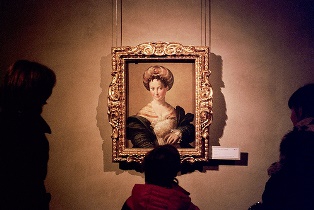
WTI Magazine #35 2014 June, 18
Author : Enrico De Iulis Translation by:
A very famous painting from the Italian Renaissance has just landed in New York, where it will be until July 20: it is the portrait of a woman celebrated as "The Turkish slave" by Francesco Mazzola, known as Parmigianino. Dated 1533, the painting is one of four female portraits painted by the well-known painter from Parma, who was one of the most famous artists of the XVI century movement that will later be called "Mannerism".
It is an extraordinary event not only for the extreme beauty of the artwork, but also because the painting has left the Italian soil only twice before this trip to the U.S.
In 1704, the author of the inventory of the collections of the Grand Duke of Tuscany describes it as "a portrait of a slave with a Turkish turban on her head and a white feathers fan in her hands".
As often happens in the history of art, this painting was handed down by a name that not only was not the original, but it was also quite misleading with respect to the nature of the painting itself.
The presence of such a turban headdress does not imply at 100% the origin of the young slave, but it is only a very fashionable hairstyle in the early decades of the sixteenth century, which was invented by Isabella d'Este and known as "Capigliara": the posture, the type of clothing and the medal hat with the emblem of a winged horse bring much more attention to the possibility of a painting about a young member of an aristocratic family in the Po Valley, which is not ... an exotic courtesan in the Middle East.
In 1928 the work came to the National Gallery of Parma through an exchange of works with the Uffizi in Florence, and from there it has almost become the official image of the institution in Parma.
The Mannerist and courtier style of Parmigianino explodes in the perfection of the details of the dress and of the hairstyle: careful attention is made to pass the flat brush for the softness of blue velvet, and then there's the use of a brush with few bristles the softness of the feathers of the fan.
The occasion of this trip has also reopened the studies and hypotheses about the identity of the woman, who of course is still unknown.
The curator of the American exhibition, Aimee Ng, proposes the name of Veronica Gambara, known poet and noblewoman from Brescia, through a reading of the clues of the clothing in the picture. The age, however, does not correspond to the portrait, unless thinking about a deliberately flattering work towards Gambara, that at the time of the making of the painting was already fifty.
From the Frick Collection, our "Turkish slave" will then reach the Legion of Honor Fine Arts Museums of San Francisco, where she will remain until October 5: it is an unmissable chance to meet one of our Italian "grandmothers", who embodies the mischievous, conscious, refined and inquiring expression of the great women of the Italian Renaissance.



